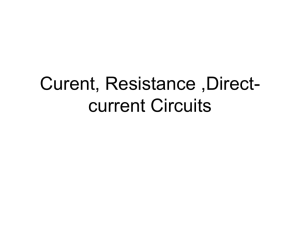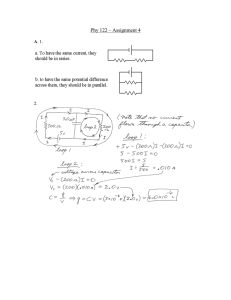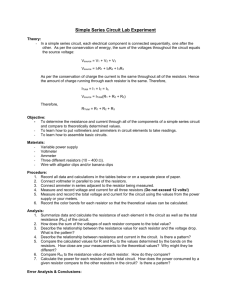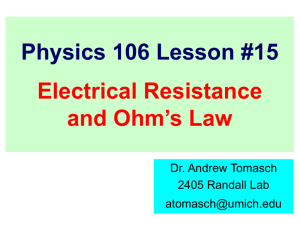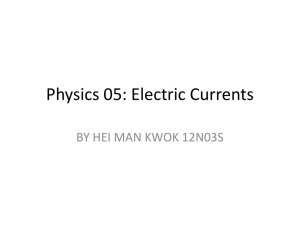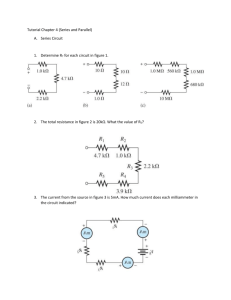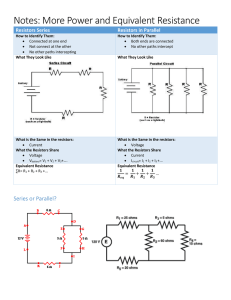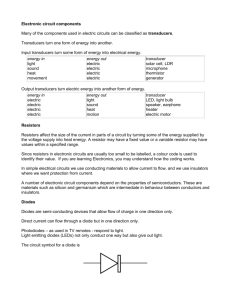PHY2054_02-08
advertisement
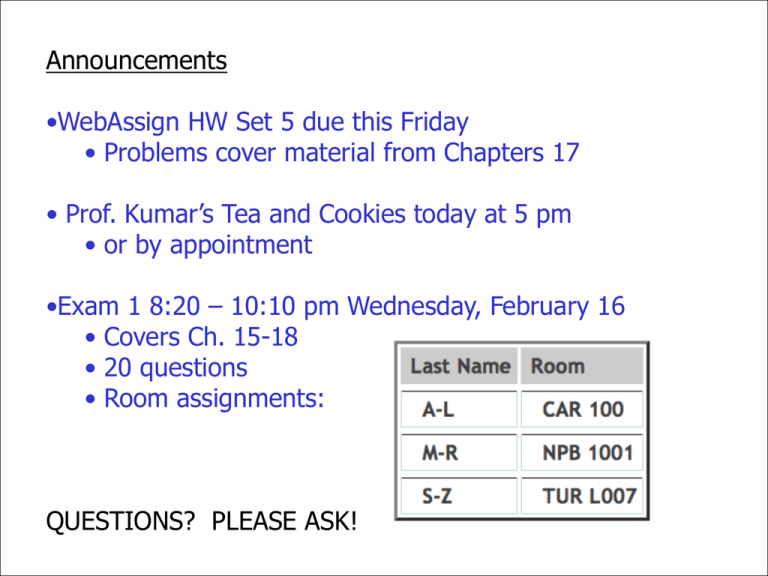
Announcements •WebAssign HW Set 5 due this Friday • Problems cover material from Chapters 17 • Prof. Kumar’s Tea and Cookies today at 5 pm • or by appointment •Exam 1 8:20 – 10:10 pm Wednesday, February 16 • Covers Ch. 15-18 • 20 questions • Room assignments: QUESTIONS? PLEASE ASK! From last time Temperature dependence of resistivity/resistance o [1 (T To )] R Ro [1 (T To )] Electrical Energy: Q t V I V 2 I R V R Superconductors Remarkable materials 2 Example Problem 17.40 A certain toaster has a heating element made of Nichrome resistance wire. When the toaster (at 20°C) is first connected to 120 V source, the initial current is 1.80 A, but the current decreases when the element heats up. When the toaster reaches it final temperature, the current is 1.53 A. (a) Find the power the toaster produces at its final temperature. (b) What is the final temperature? Chapter 18 Direct Current Circuits emf emf maintains the current in a closed circuit Any device that increases the potential energy of charges circulating in circuits; e.g., batteries and generators SI units are Volts The emf is the work done per unit charge Real batteries have small internal resistance Therefore, the terminal voltage is not equal to the emf Internal Resistance internal resistance r Terminal voltage: ΔV = Vb-Va ΔV = ε – Ir This is the voltage drop that the circuit ‘sees’ For the entire circuit, ε = IR + Ir load resistance R When R >> r, r can be ignored Generally assumed in problems Power: I e = I2 R + I2 r When R >> r, most of the power delivered by the battery is transferred to the load resistor Resistors in Series Current is the same in R1 and R2 Conservation of charge ΔV = ΔV1 + ΔV2 = IR1 + IR2 = I (R1+R2) = I Req General: Req = R1 + R2 + R3 + … The equivalent resistance has the effect on the circuit as the original combination of resistors Equivalent Resistance – Series: An Example Four resistors are replaced with their equivalent resistance Resistors in Parallel Equivalent resistance replaces the two original resistances Equivalent Resistance – Parallel Current splits at upper junction: I = I1 + I2 + I3 Write in terms of voltage drop DV DV DV DV = + + Req R1 R2 R3 Equivalent Resistance 1 Req = 1 R1 + 1 R2 + 1 R3 +… The equivalent resistance is always less than the smallest resistor in the group! Example Problem 18.8 (a) Calculate the equivalent resistance of the 10 Ω and 5 Ω resistors. (b) Calculate the combined equivalent resistance of the 10 Ω, 5 Ω, and 4 Ω resistors. (c) Calculate the equivalent resistance found in part b and the parallel 3 Ω resistor. (d) Combine the equivalent resistance from part c and the 2 Ω resistor. (e) Calculate the total current in the circuit. (f) What is the voltage drop across the 2 Ω resistor? (g) Subtracting the result of part f from the battery voltage, find the voltage across the 3 Ω resistor. (h) Calculate the current in the 3 Ω resistor. Example Problem 18.13 Find the current in the 12 Ω resistor. Solution to 17.40 Solution to 18.8 (I) Solution to 18.8 (II) Solution to 18.13 (I) Solution to 18.13 (II)




